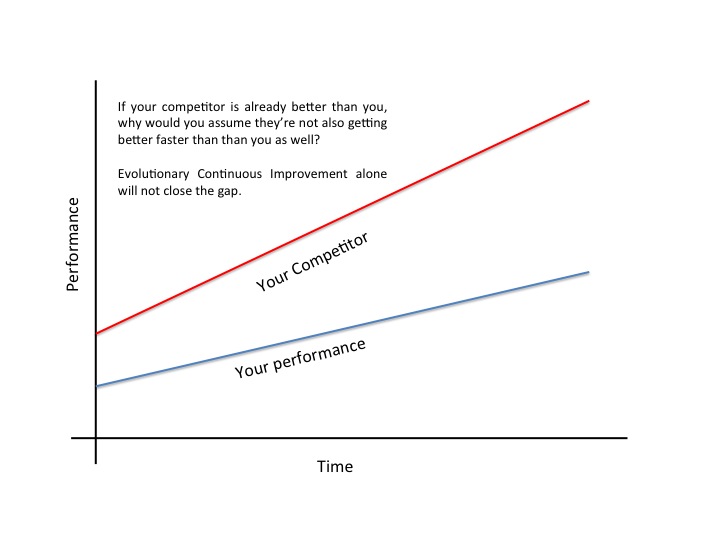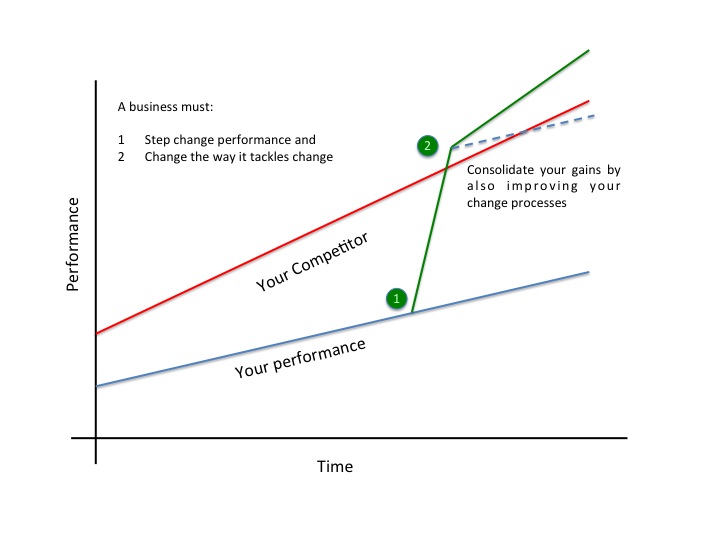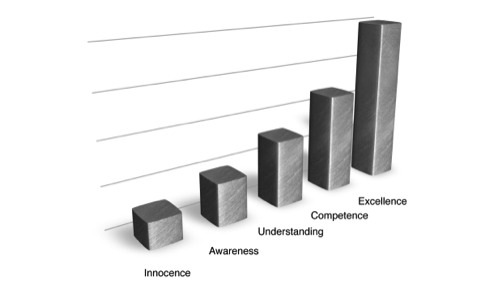Leadership
History is littered with tales of brave soldiers being let down by poor generals and of great leaders triumphing against seemingly impossible odds to win through in even the most desperate of situations.
Business is no different. Great leaders make a real difference. There are very few examples of great businesses flourishing under poor leadership yet there are many tales of a great leader delivering extraordinary performance out of what had previously been a relatively modest business.
Extensive surveys of successful businesses and especially of businesses undergoing successful change repeatedly discover that leadership is the number one determinant of success. The great news is that it is also one of the easiest things to affect, because it’s down to you.
Leadership isn’t needed throughout the organisation but must shine like a beacon from the most senior management.
At the most junior levels in an organisation, workers need to master a range of tasks that need to be repeated to a consistently high level to produce a high quality output. These tasks may or may not require high levels of skill to perform but whatever they are and whatever skills are needed the life blood of the business depends on them being performed consistently and on a timely basis. It’s the actions of these people within the organisation that pays the bills.
The supervisors of these workers coordinate and orchestrate a series of these tasks to ensure flow through the business is maintained, from the raw materials coming into the warehouse through to the final goods being despatched to the customer. In a well-organised business, with well-defined processes, this supervisory task should be about flow, pace and momentum and not the organisation of chaos!
Managers balance these flows in response to changing needs and ensure that resources are at the appropriate levels to meet these demands.
The executive oversee this hive of activity and have the added responsibility of predicting what will be required from the business in the future, setting goals, targets and objectives. This in turn provides the framework for the rest of the organisation to function. There’s more detail on this in another article.
Consistency of purpose
So at its heart, leadership is about direction, objectives and the pace of the journey. Most great leaders have discovered that it is more important to be clear about these objectives and the path to achieving them than it is to fret about choosing the perfect objective for their given situation.
Choose the direction, articulate it clearly and often and then stick to your guns. This clarity and consistency of purpose is the single most helpful thing a leader can do. If people are continually reminded of the objective then it is easier for them to judge if their actions are being effective.
Communication
Embedded in the challenge above is the need for great leaders to be great communicators. It continues to be a surprise to find that many people in leadership positions really struggle with this aspect of their responsibilities. It’s difficult to see how a leader can provide effective leadership if they can’t articulate clear messages. If communications come naturally to you or if it is something you need to work on you must do it. There’s no point in having an objective if no one knows what it is and the journey will be frustrating if no one knows how their doing. Communication mustn’t be seen as occasional big events or fancy newsletters. While these have their place what’s really needed is intimate, frequent and straightforward communication. The often cited numbers that people remember 20% of what they hear, 30% of what they see and 50% of what they hear & see are not actually backed by any credible scientific study but this should not detract from the principle that the more people get involved in something the more likely they are to understand and absorb it. Without doubt, communication by email is the very worst form of communication. Communication is also the subject of an article of its own.
Face the Front
If communication is the most important discipline during a change program, the most important thing to communicate is the objective. Many leaders get hung up about the details of the journey, but your perspective of these elements will be very different to that of many of your stakeholder groups, most particularly your employees. Equally, you may not be the right person to determine the details of the journey (actually your certainly not the right person). Your task is to Face the Front, and to focus the organisation on where it is going and why. You, more than anyone else, must balance the need for performance today with the objective for tomorrow. The challenge of raising a standard, creating a beacon, which becomes a touchstone for the whole business, is the subject of an article in its own right.
Fairness
Once the journey begins, while I hope your not defining every step of the way, it is your responsibility to ensure certain immutable values are adhered to. N the most case the value system for an organisation cannot be wholly prescribed by the senior management. An organisation’s culture is the ‘way things get done around here’ and not necessarily the way management would like them done. That being said it is the responsibility of management to insist on certain values. While certain ones, such as keeping it legal and ethical I would hope go without saying, one, which I see being lost too often, is the value of fairness.
Change affects different populations differently. I’ve found for example that it’s helpful to divide the workforce into four groups. At one extreme there are the worst performers, who know that they are and possibly don’t even care. They’ll remain sceptical and critical, but in my experience don’t usually disrupt things too actively. Hopefully it’s not too big a group, however one other truth is that if you find you need to downsize you’ll be extremely unlikely to be able to achieve this simply by losing this bottom group.
At the other end of the scale are your highest performers, who are confident in their value to the organisation. As long as communication is good, they’ll usually remain positive, but you shouldn’t take them for granted! Unfortunately, in most businesses, this is a disconcertingly small group – perhaps less than 10% of the total workforce.
It’s the middle two groups who need to be managed effectively. Towards the first extreme are a group of average performers, but upon whom the business is not critically dependent. They will often react with cynicism and can become highly disruptive as they rarely see the positive in a change program and usually see it as attacking their way of life. Communicate to them veraciously but don’t become too distracted by their negativity.
It’s the final group that provide the greatest challenge. These are medium and high performers upon whom the business is critically dependent, but they lack the personal confidence that they are vital to the future or even a part of that future. While communication will help, alone it is not enough. You need to get and keep this cadre onside of the change program is bound to fail. This group, above all the others, need to know that decisions are being made fairly and on the basis of solid process and sound analysis. This group needs to see transparent processes, which are not ‘made up as you go along’ and be allowed to understand the attributes that you value during the change and in to the future. This will help them judge for themselves that they ‘fit’ and they’ll want to stay and help.
Plan Do Check Act
Having said your shouldn’t make it up as you go along, things will change and unforeseen circumstances will arise. Dr Edward Deming made famous the Plan-Do-Check-Act cycle, which was initially applied to product quality. I’m sure he’d be the first to acknowledge that it is based on the ‘scientific method’ which every school child learns, and which has been around since the 17th Century. Its simplicity has far greater appeal than just for the control of product quality and it is particularly helpful as a ‘conscience’ during a change program.
Plan what you’re going to do (don’t just make it up as you go!) but don’t spend all of your time ‘getting ready to get ready’ as one of my old bosses used to say. Plan and then Do what you said your were going to do. However don’t just do it blindly, check it’s having the desired effect. Business is complex and we have to make decisions on the basis of imperfect information. Check things are working as you intended and if not have the courage to take swift corrective action. If it has worked, then ensure it will stay working that way – as the Americans say ‘put it down so it stays down’!
My favourite progress reviews go along the lines: ‘In this period we did everything we said we would at the last review. The actions had the effect we anticipated and this is what we intend to do in the next period’, or sometimes ‘ We did everything we said we would but found that XYZ didn’t work as intended, so this is what we intend to do now’.
Concern for Impact
A really important component of the check element of this cycle is for you to check if you’re ‘working’. I’ve seen lots of leaders read the beginning of articles like this – define fantastic strategies, create impressive communication collateral and the most elegant of plans and measurement systems. Unfortunately that fail to check if anyone is actually listening to what they have to say and if they are if they’re hearing the right message. English is a complex language, just look how much trouble the British have understanding the Americans and vice versa! At a time of change the smallest word can conjure the most enormous of spectres, which completely colour, distort or even block how everything else is heard or perceived.
I first came across the term ‘concern for impact’ when working with ICI in the 1980s. They defined it as an essential core competence for all senior management. I must confess that at the time I thought it was just so much management ‘mumbo jumbo’, but over the years I’ve come to acknowledge that it is one of the critical things that differentiates truly great leaders from the rest of us. These peerless champions of excellence really do care if what they do personally is having the effect they intended and continually adapt and develop their behaviour and actions to ensure that the target audiences get what they the audience need, which in turn delivers what the business needs.
Flexibility
So change is really all about change – it’s the only constant in a change program! Great change programs are not about getting it perfectly right on day one. It’s about clear objectives, clear pathways and responsibilities, with sufficient checkpoints to illuminate how things are going.
The best programs are not the ones that have the best plan to start with; they’re the ones where the management team have had the courage and skills to spot issues and then adapt flexibly to unforeseen and changing circumstances. After all, if this is going as we hope then at the very least customers will want to start buying more from you – no one has the luxury of making change happen in a hermetically sealed bubble.
Learning not blaming
It also goes without saying that you’re not going to get everything right all of the time. Even in the best of times this is beyond most of use. In the circumstances of rapid change, first you’ve created a dynamic environment so you and your team need to react. Secondly this is a situation many of your management team have not faced before and perhaps even you’ve not. It is easy however to start looking for scapegoats to blame when things start to drift of course.
While this can be cathartic, it is a waste of energy and if things are off course the most important priority is to get things back on course and the next priority is to make sure whatever conspired to cause the initial issue does not happen again.
That’s called learning – even if it is learning from your mistakes. Every great organisation, and I mean EVERY great organisation is great at doing this.
Over the years I’ve both supplied to and worked for the Nissan organisation in the North East of England. While they offer a fantastic exemplar of a transplanted Japanese manufacturing facility, for me the most fascinating aspect of their success and one they speak of, in my opinion far too infrequently, is how they react when things go wrong. That’s also the subject of another article.
Delegation
I said earlier on in this article that the leader is unlikely to be the right person to determine every last detail of the journey. You set the objectives, provide a beacon for both the journey and the value system and then you need to create the culture of trust that empowers others to take on the detailed tasks that move this business forward.
I’ve deliberately put delegation almost at the bottom of this article, not because it’s unimportant, almost the exact opposite. All of the things above need to be in place otherwise your attempts to delegate are very likely to come crashing down.
While I’ve always had the personal ethic that I don’t expect anyone in an organisation to work harder than me, I do also expect many of the workforce, and particularly my senior management team, to work as hard as me. One of the tasks that will probably ensure you continue to work the hardest of all is that you are one of the key individuals in dividing up the responsibilities and the tasks to ensure that delegation can cascade throughout the organisation.
It is one of the most difficult of the leadership challenges and it also offers one of the greatest rewards. Achievements accomplished by a team are always sweeter than the solo accomplishments of an individual. For a start there are a group of people to go out and have that celebration dinner with and believe me celebrating success is an essential part of cementing the achievements you make during the change program.
Listening
During that dinner, you can continue to practice one other really difficult leadership challenges – the skill of listening. I don’t just mean not speaking, I mean taking an interest in what others have to say.
By actively listening you can absorb the experience of those around you and share their learning as well as that which you’ve undertaken directly. By doing this you become more than just the sum of your own actions.
One of my clients once said to me, as I was relating yet another past situation that I felt shed light on their current challenge, “You can’t possibly have done all these things”? Yet the reality is that I have because I constantly absorb as much as I can from every possible environment and you can only do that with the ‘input’ senses and in business listening is the critical one of these.
Listen and learn, oh and don’t forget to celebrate your successes!
















